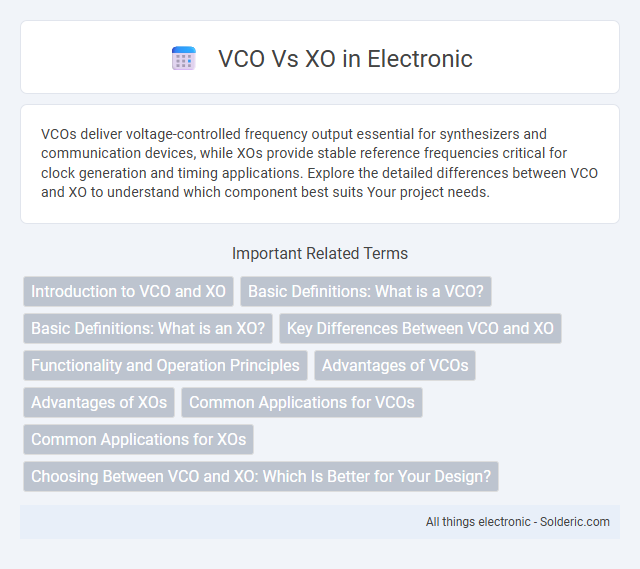VCOs deliver voltage-controlled frequency output essential for synthesizers and communication devices, while XOs provide stable reference frequencies critical for clock generation and timing applications. Explore the detailed differences between VCO and XO to understand which component best suits Your project needs.
Comparison Table
| Feature | VCO (Voltage-Controlled Oscillator) | XO (Crystal Oscillator) |
|---|---|---|
| Frequency Control | Continuous frequency tuning via voltage input | Fixed frequency determined by crystal |
| Frequency Stability | Moderate stability, varies with temperature and voltage | High stability, precise frequency due to crystal resonance |
| Phase Noise | Higher phase noise compared to XO | Low phase noise, superior signal purity |
| Applications | Frequency synthesis, modulation, PLL circuits | Clocks, timing references, communication systems |
| Complexity | Simple to integrate, flexible tuning | Requires precise crystal, less flexible |
| Cost | Generally lower cost | Higher cost due to crystal component |
Introduction to VCO and XO
Voltage-Controlled Oscillators (VCOs) are electronic oscillators whose frequency varies based on an input voltage, widely used in frequency modulation and signal synthesis applications. Crystal Oscillators (XOs) rely on the mechanical resonance of a piezoelectric crystal to maintain a stable and precise frequency, crucial in clock generation and timing circuits. Your choice between VCO and XO depends on the required frequency stability and tunability in your electronic design.
Basic Definitions: What is a VCO?
A Voltage-Controlled Oscillator (VCO) is an electronic oscillator whose oscillation frequency is controlled by an input voltage. VCOs are widely used in phase-locked loops, frequency synthesizers, and modulation circuits due to their ability to generate variable frequency signals. Their frequency range and stability depend on the design of the voltage-controlled capacitive or inductive components within the oscillator circuit.
Basic Definitions: What is an XO?
An XO, or Crystal Oscillator, uses the mechanical resonance of a vibrating crystal, typically quartz, to generate a precise and stable frequency reference. Unlike a Voltage-Controlled Oscillator (VCO), which adjusts frequency based on input voltage, an XO maintains a fixed frequency determined by the crystal's cut and size. Your electronic design benefits from an XO's high frequency stability and low phase noise in applications requiring accurate timing signals.
Key Differences Between VCO and XO
VCO (Voltage-Controlled Oscillator) frequency varies based on input voltage, offering tunability for your signal generation needs, while XO (Crystal Oscillator) provides a fixed, highly stable frequency determined by its quartz crystal. VCOs excel in applications requiring frequency modulation or wide frequency ranges, whereas XOs are preferred for precision timing and low phase noise. Reliability and frequency stability are key differentiators, with XO delivering superior long-term stability compared to the inherently variable nature of VCO.
Functionality and Operation Principles
A Voltage-Controlled Oscillator (VCO) generates an oscillating signal whose frequency varies based on the input voltage, relying on reactive components like varactors or capacitors to adjust frequency dynamically. In contrast, a Crystal Oscillator (XO) utilizes the mechanical resonance of a quartz crystal to produce a highly stable and precise frequency, operating with piezoelectric effect-based components. While VCOs offer tunability for frequency modulation in communication systems, XOs provide fixed-frequency outputs crucial for timing and synchronization applications.
Advantages of VCOs
Voltage-Controlled Oscillators (VCOs) offer superior frequency tuning range compared to Crystal Oscillators (XO), making them ideal for applications requiring dynamic frequency adjustments. They provide faster response times and greater flexibility in phase-locked loop (PLL) systems, enhancing frequency synthesis accuracy. Your design benefits from VCOs' compact size and lower cost, especially in communication devices where rapid frequency variation and integration are critical.
Advantages of XOs
XOs (Crystal Oscillators) offer superior frequency stability compared to VCOs (Voltage-Controlled Oscillators) due to their reliance on quartz crystals, which maintain a consistent oscillation frequency despite temperature changes. They exhibit low phase noise and jitter, making them ideal for high-precision timing applications in telecommunications and digital circuits. The fixed frequency output of XOs ensures reliable synchronization in systems requiring exact clock signals, unlike VCOs that are more susceptible to drift and require continuous calibration.
Common Applications for VCOs
Voltage-Controlled Oscillators (VCOs) are widely used in phase-locked loops (PLLs) for frequency synthesis, enabling precise tuning in communication systems and signal processing. Their ability to vary output frequency based on input voltage makes them essential in RF transmitters, modulators, and frequency modulators in wireless devices. VCOs are also integral in sensor systems for oscillation frequency control and in voltage-controlled filters and oscillators within integrated circuits.
Common Applications for XOs
Crystal Oscillators (XOs) are widely used in communication systems, including radio transmitters and receivers, where stable frequency generation is critical. XOs provide precise timing in electronic devices such as microcontrollers, smartphones, and GPS modules for synchronization purposes. Their low phase noise and high frequency stability make them ideal for clock generation in computing and networking hardware.
Choosing Between VCO and XO: Which Is Better for Your Design?
Choosing between a Voltage-Controlled Oscillator (VCO) and a Crystal Oscillator (XO) depends on your design's requirements for frequency stability and tuning range. VCOs offer wide frequency tuning and adaptability, making them ideal for applications like phase-locked loops and agile frequency synthesizers, while XOs provide superior frequency stability, low phase noise, and precise frequency accuracy, critical for timing-sensitive circuits. Your decision should weigh the need for dynamic frequency control against the priority of stable, fixed-frequency output.
VCO vs XO Infographic

 solderic.com
solderic.com